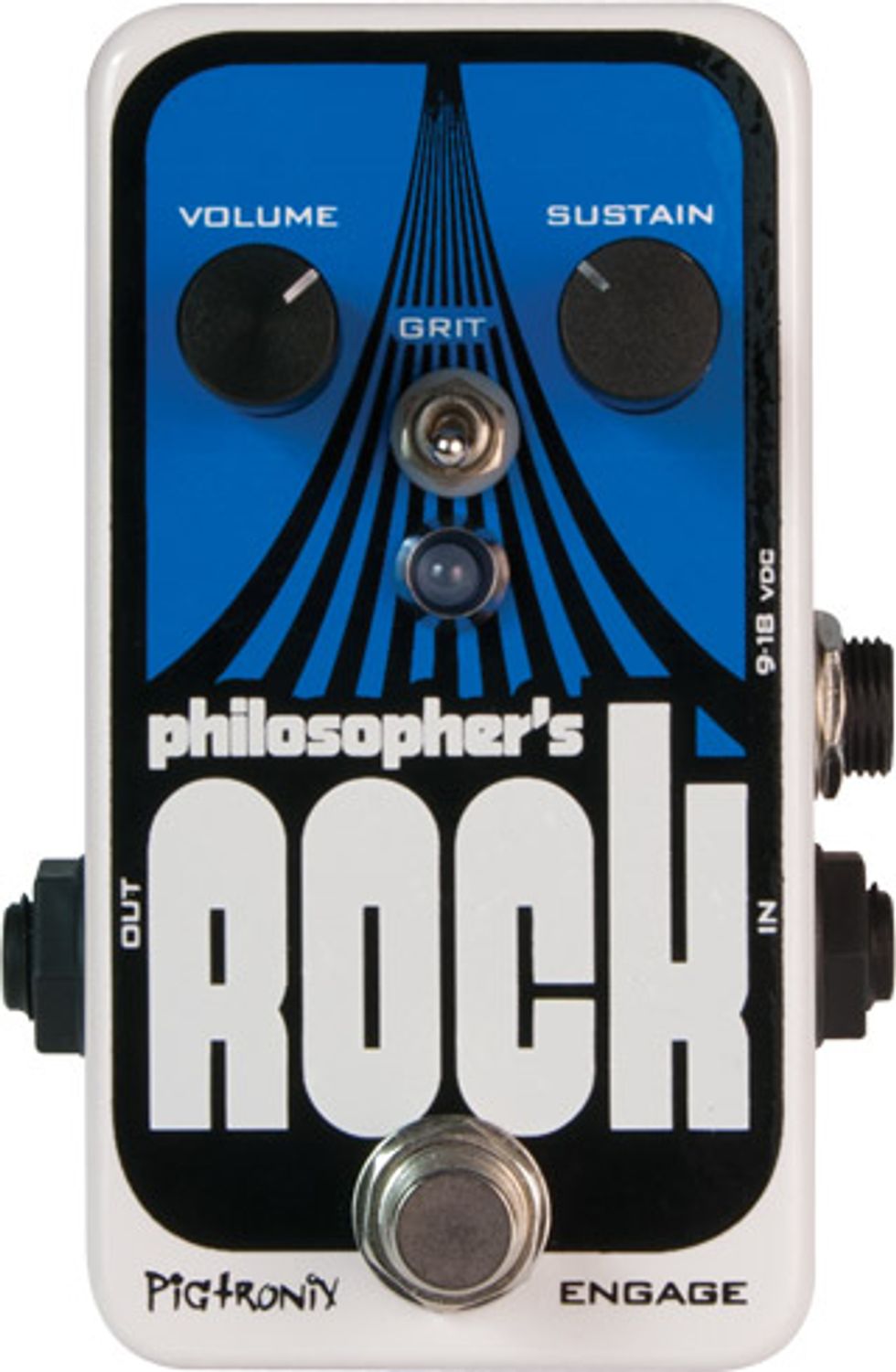In an industry where being called a “clone” can actually be a compliment, Pigtronix manages to stay prolific in unique ways. The company rarely delivers a strictly traditional take

In an industry where being called a “clone” can actually be a compliment, Pigtronix manages to stay prolific in unique ways. The company rarely delivers a strictly traditional take on anything, and the Philosopher’s Rock is yet another article of evidence speaking to the New York-based manufacturer’s evolutionary mindset—even if it takes on relatively few simple tasks, especially in comparison to previous Pigtronix offerings. Based on the company’s rave-garnering Philosopher’s Tone, this compressor is designed to deliver the same signature sustain in a more compact pedal. But it also comes packed with a few surprise features, such as the grit toggle, which enables you to move from fully compressed clarity to aggressive, germanium-fused distortion with the flip of a switch.
Stone Cold Simple
The all-analog Philosopher’s
Rock is housed in a compact
enclosure that’ll take up minimal
room on your pedalboard. But
to squeeze all the circuitry and
guts into this compact design,
Pigtronix had to eliminate the
option for a battery—you can
only power it with a 9V–18V
adapter. Fortunately, it comes
with an 18V plug—which also
happens to be good for signal
response and headroom.
Compared to its older sibling, the Rock has considerably fewer knobs to tweak. In return for its smaller footprint, it sacrifices treble and blend controls, but Pigtronix has dialed parameters controlled by those knobs in to a sweet spot from the factory. Volume and sustain controls remain, however. For more compression, roll the latter clockwise, or roll it off to let your tone breathe in the upper and lower registers.
The Rock’s slickest attribute is the grit toggle, which engages a harmonically rich germanium distortion. With grit engaged, volume and sustain still shape the tone, and the sustain control is particularly effective for soaring, string-/synth-type distortion when you crank it, or more brawny, unraveled-sounding tones at its lowest.
Gritty Performance
I plugged the Philosopher’s Rock
into a late-’60s Fender Bassman
with a matching 2x12 cabinet
and a Fender Telecaster on the
opposite end of the chain. With
the Rock’s controls at noon, a
simple campfire chord exhaled
with near perfect symmetry from
low to high notes. With volume
set at noon, you’ve got unity gain
with a single-coil-equipped guitar,
so there’s plenty of headroom on
tap—especially when you use an
18V—if you need to boost your
compressed signal. Kicking sustain
up to around 2 o’clock substantially
chokes the frequency band,
but the output retains a musical,
fluid quality that’s nice for clean
lead lines. Turn sustain past 4
o’clock, and there’s a significant
increase in output volume, accompanied
by a little white noise.
At these levels, you’ll likely start
to battle some feedback issues,
which means you might have less
flexibility to use high-gain pedals
or use the effect aggressively at
high amplifier volume. That said,
Pigtronix designed this pedal to
generate good, musical harmonic
feedback. And when it can be
tamed, this aspect of the pedal’s
performance can be a real asset.
Ratings
Pros:
Unique combination of germanium distortion
and compression yields unique tones.
Cons:
Can be just a little tough to tame.
Tones:
Ease of Use:
Build:
Value:
Street:
$149
Pigtronix
pigtronix.com
With a humbucker-equipped Les Paul in the mix, the grit function is a blues-rocker’s dream. Again, the distortion isn’t exactly easy to tame, but the germanium drive circuit has a cool voice—a nasally treble response with a gravelly foundation. Keeping sustain around noon is very conducive to generating singing single notes, though not surprisingly, aggressive sustain settings promote feedback— especially with chords that generate a lot of overtone content.
Slide players of all kinds will find a great friend in the Rock’s grit sounds, which can deliver a great combination of singing and filthy tones. And flipping between the bridge and neck position on a Les Paul can produce a chunky, stouthearted lead tone that summons thoughts of Haynes and Trucks kicking up an Allman-style crossfire.
The Verdict
The Philosopher’s Rock is an
occasionally odd, but often
very effective, hybrid of compression
and distortion. It would be
nice to be able to control both
functions independently, given
that switching between compression
and grit mode can yield very
disparate sounds that require
substantial sustain- and volumeknob
tweaks. On the other hand,
the magic of the Rock is just
how many sounds you get from a
small package. The tones within
are rich, great for adding clarity
or filth to leads, or for adding
definition to distorted rhythms.
What’s best is that these are not
generic compression or distortion
tones: Like many Pigtronix
pedals, the Philosopher’s Rock
inhabits unique sonic territory,
and if you’re willing to do the
homework it takes to tame
this pedal and summon the
best tones, you’re likely to be
amply rewarded.

